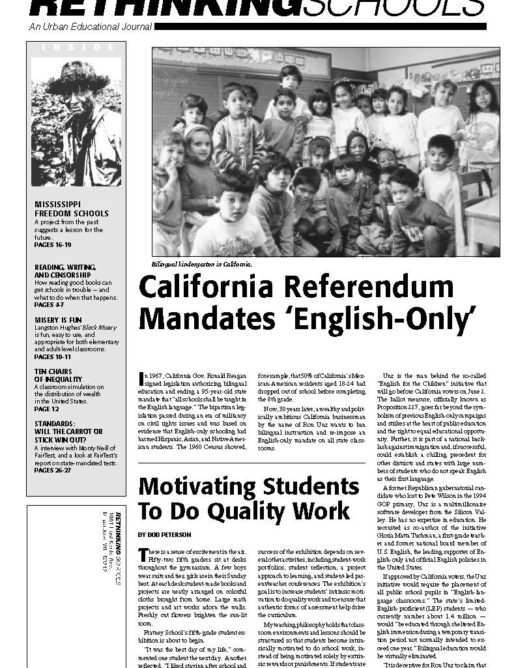Preview of Article:
Ten Chairs of Inequality
A Classroom Simulation on the Distribution of Wealth
I then announce that Sue’s arm represents the wealthiest 1% of families and that her arm’s share of the wealth doubled from 2 chairs (22% of the wealth) to 4 chairs (42%) during the years from l979 to l992. I solicitously help Sue find a comfortable position with one arm stretched over four chairs. To engage Sue in clowning and playing up her role, I offer her food or drink.
I ask the other nine students crowded around three chairs what life is like at their end of the line. “We’re pissed and tired of working all the time,” is a typical comment. Another is, “I want a revolution.” I ask students if, in real life, they or people they know are crowded into the bottom one or two chairs, and what that’s like. Working-class students tell stories of financial stress they have experienced, such as, “My mother had to work two jobs to support us.” “My family was really poor when my dad was laid off. We lived on macaroni and cheese.” Often one student, usually a white male, says he has hopes that he can work hard and join Sue.
Students’ knowledge of how inequality is rationalized erupts when I ask, “What do those in power tell us about how to justify this dramatic inequality?” Typical student answers are: “They work harder than we do.” “They create jobs.” “The U.S. stands for equality and justice for all.” “It’s our fault if we don’t make it.” If students do not mention scapegoating, I bring it up. I may select one student to represent the poorest 10% and ask, “Wouldn’t there be more money for the rest of you if he or she weren’t ripping off the system for welfare?” I also ask, “Who might Sue want you to blame for your tough economic conditions?” Answers range from welfare mothers and immigrants to gays and lesbians, or bad schools.
When I ask the nine students grouped around the three chairs why they don’t get organized to force a redistribution of the wealth, they offer a variety of answers. “We’re too busy working to organize.” “We are told we can’t change things.” “We don’t get along with each other.” “They’d call out the army to stop us.”
At some point I ask the class to describe the “super rich” — the 1%, Sue’s arm. College students share examples from their experiences. A junior high coach described a local billionaire who offered to write the coach’s school a check of any amount in order to get his child on the baseball team. Another student worked as a waiter in an elite club where “you had to be elected to be able to have lunch there.” The club was all white and only recently began allowing women on the premises; some of the older men refused to let her serve them because they resented her presence. Another student described doing carpentry in a mansion of the Duponts, “The faucet in the kid’s bathroom cost $3,000. “</p

